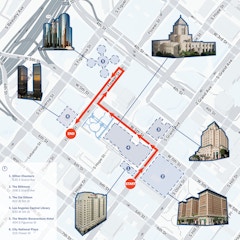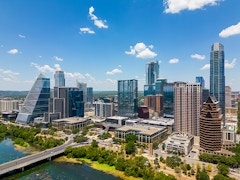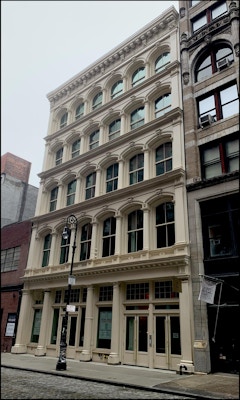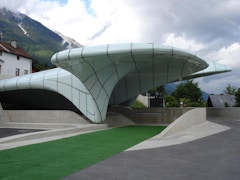
71 results
-

-
Saving Face
- Paper by Xsusha CarlyAnn Flandro, FAIC, APT-RP
In 1871, a fourth level Architecture course was offered in New York City that instructed on topics such as heating, ventilation and circulation of
-

Daylighting Parametric Workflows Used for Adaptive Reuse
- Paper by Alfonso E. Hernandez, AIA, NCARB, LEED BD+C,
Daylighting & Solar Glare control, which affect both the energy consumption of the building as well as the comfort of the occupants, become… -

FTI LA-hub: DTLA Facades Walk
- Event by Facade Tectonics Institute, McCarthy Building Companies
Calling all local facade geeks and urban architecture fans! It'll be a short walk, a matter of just a few blocks, but it affords the opportunity to view and discuss 6 buildings of considerable historical and architectural interest.
-

Contextual Envelopes
- Paper by Zoltan Neville
Aesthetic and technical capabilities of facade design have become seemingly endless as building technologies progress. While the capacity to address
-

The Craft of Building Enclosures
- Paper by Christopher Payne, AIA, LEED AP, Senior Project Architect
This paper will provide case studies of two high-performance building envelopes in the San Francisco Bay Area where the fabrication of bespoke façade… -
Adaptive Reuse of Industrial Heritage Façades
- Paper by Bahar Basarir, PhD · Hatice Yasemin Cakir
With the developments in production, industrial facilities lost their function and were abandoned over time. The most frequent and often the most
-
Reglaze or Replace?
- Paper by Angel Ayón, AIA, LEED AP, Principal Laura Boynton, AIA, LEED AP, Senior Associate
Originally known as The Master Building, 310 Riverside Drive in Manhattan's Upper West Side is a 28-story tower completed in 1929 as an apartment… -

Facade Games
- Paper by James Tice
This paper provides an overview of a course focusing on the façade as taught to architecture students over a twenty-year period. The need for this
-

BUILDING ENCLOSURE SCIENCE & TECHNOLOGY CONFERENCE
- Event by National Institute of Building Sciences (NIBS)
BEST6 - The Next Generation of Building Technology
-

Modern Heritage and Facade Improvements
- Paper by Uta Pottgiesser · Angel Ayón
Approximately 80% of our total building stock is from the 20th century. During the last decades, along with an increasing appreciation of modern
-

Developments in Gridshell Design
- Paper by Cristobal Correa P.E. · Craig Schwitter P.E.
In 1959 Heinz Isler challenged the world of concrete shell design by proposing a series of shapes for shells that were very different from what most
-

Event Passed
APT Seattle Conference Symposium 2023: Aging Composite Materials and Assemblies
- Seattle, United States
Aging modern heritage buildings and structures face complex repair and reinvestment challenges. Manufactured composite materials and multi-material assemblies often cannot be cost-effectively repaired or replaced in kind.
Industry Event by Association for Preservation Technology
-
Cities under Climate Threat - Philadelphia, Rome and Venice
- Paper by Edgar Stach, Dr., Ing, AIA/IA · Shreya Kanther · Alexis Manfre
The impacts of climate change, driven by increasing extreme temperature, sea-level rise, and heavy precipitations, interact and play an essential
-
Facing Density
- Paper by Wendy Cox,
The United Nations Department of Economic and Social Affairs projects a world population growth of over three billion over our current, nearly eight… -
The Tectonics of Flimsiness
- Paper by Timothy Brown AIA NCARB CSI
Architecture has traditionally celebrated the joining of two building components or materials. Joinery serves as a key site for architectural
-
Blurred Edges
- Paper by Elizabeth L. McCormick AIA, WELL AP, LEED AP, CPHC
Sealed indoor environments have created artificial, homogeneous ecosystems that sever ties between humans and the natural world. This paper
-

Kinetics in Building Facades
- Paper by Sean Cullen · Professor Greg Keeffe
The prominence of climatically responsive building facades through the use of kinetics has proliferated in recent years due to a concern for the
-
Renewing Two Saarinen Icons
- Paper by David N. Fixler, FAIA · Gary Tondorf-Dick, AIA, LEED AP · Katherine S. Wissink, PE · Matthew B. Bronski, PE
Kresge Auditorium and the MIT Chapel, designed by Eero Saarinen and built in 1955, are both world renowned works of architecture and powerful symbols
-
Saving Small Towns
- Paper by Leah Kemp
Small towns are dying, and it is not just because of their dwindling economies. The physical fabric of our communities is literally crumbling. A


